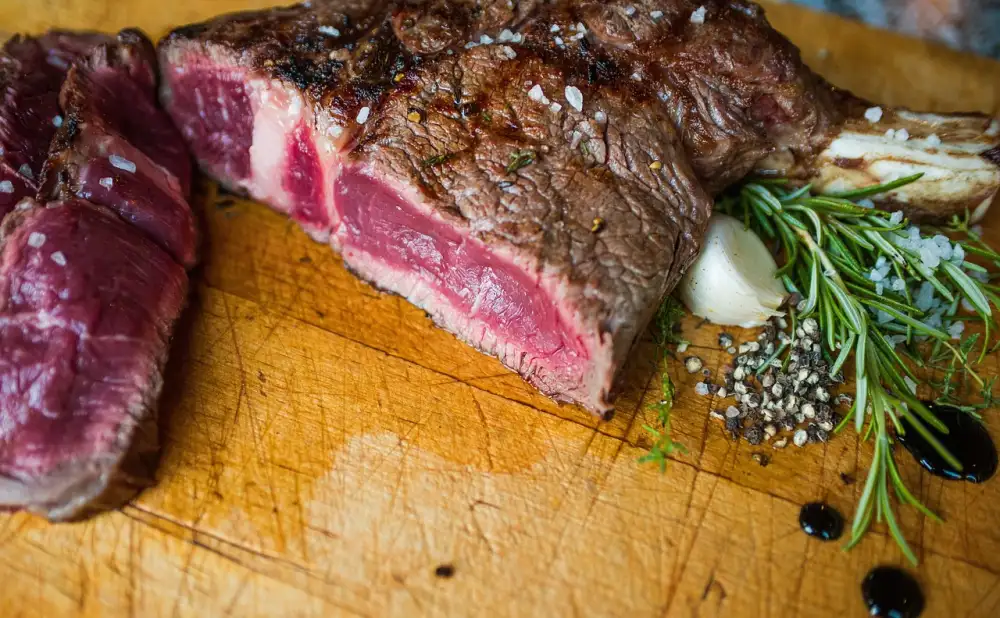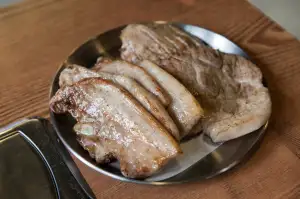Juicy Delights: Savor the Magic of Rare Steak with our Mouthwatering Recipe!

- Benefits of cooking steak to a low degree of doneness
- Choosing the right cut of meat for rare steak
- Preparing the steak for cooking
- Cooking techniques for achieving a rare steak
- Seasoning and flavoring options for rare steak
- Serving suggestions and accompaniments for rare steak
- Tips for achieving the perfect rare steak
Rare steak is a culinary delight that offers a unique and unforgettable dining experience. It refers to a method of cooking steak where the internal temperature is kept low, resulting in a juicy and tender texture with a vibrant pink center. Unlike well-done steaks, rare steaks are cooked for a shorter period, allowing the natural flavors of the meat to shine through. This cooking style has gained popularity among food enthusiasts who appreciate the succulent taste and melt-in-your-mouth tenderness of a perfectly cooked rare steak. Whether you're a seasoned carnivore or an adventurous food lover, exploring the magic of rare steak is sure to elevate your dining experience to new heights.
Benefits of cooking steak to a low degree of doneness
Cooking steak to a low degree of doneness, also known as rare, offers several benefits. Firstly, the meat retains its juiciness and tenderness, resulting in a melt-in-your-mouth texture. The natural flavors of the beef are preserved, providing a more intense and authentic taste experience. Additionally, rare steak is easier to digest compared to well-done steak, as the cooking process breaks down the proteins and connective tissues without drying out the meat. This lower degree of doneness also ensures that essential nutrients such as iron and B vitamins are retained, contributing to a nutritious meal. So, by opting for rare steak, you not only indulge in a flavorful delight but also reap the health benefits it offers.
Choosing the right cut of meat for rare steak
When it comes to choosing the right cut of meat for a rare steak, there are a few factors to consider. First and foremost, opt for a tender cut such as filet mignon, ribeye, or strip steak. These cuts have less connective tissue, making them more suitable for cooking to a low degree of doneness. Additionally, marbling is key. Look for steaks with generous marbling throughout the meat, as this will enhance both the flavor and juiciness of the final dish. Finally, consider the thickness of the steak. Thicker cuts tend to retain their juiciness better when cooked rare. By selecting the right cut of meat, you'll ensure that your rare steak is not only flavorful but also tender and succulent.
Preparing the steak for cooking
Preparing the steak for cooking is a crucial step in achieving a perfectly cooked rare steak. Start by ensuring that the steak is at room temperature, as this allows for even cooking. Pat the steak dry with paper towels to remove any excess moisture, which can hinder browning. Next, season the steak generously with salt and pepper on both sides, enhancing its natural flavors. For an extra boost of flavor, you can also marinate the steak in your favorite herbs and spices for a few hours before cooking. Lastly, allow the seasoned steak to rest for about 30 minutes before cooking to ensure tender and juicy results.
Cooking techniques for achieving a rare steak
Cooking a rare steak requires precision and careful technique to achieve the perfect balance of tenderness and juiciness. Here are some cooking techniques that will help you achieve a rare steak:
1. Searing: Start by searing the steak on high heat for a short period of time. This will create a flavorful crust on the outside while sealing in the juices.
2. Oven Roasting: After searing, transfer the steak to a preheated oven to finish cooking. This method allows for even heat distribution and ensures that the steak is cooked evenly throughout.
3. Reverse Searing: This technique involves slow-cooking the steak at a low temperature first, then finishing it off with a quick sear. It results in a tender interior with a beautifully caramelized exterior.
4. Sous Vide: Using a water bath set to a precise temperature, cook the steak slowly and evenly. Finish it off with a quick sear for added flavor and texture.
Remember, cooking times may vary depending on the thickness of the steak and personal preference. Use an instant-read thermometer to ensure that the internal temperature reaches around 125°F (52°C) for medium-rare doneness.
Mastering these cooking techniques will help you unlock the magic of rare steak, delivering a succulent and melt-in-your-mouth experience with every bite.
Seasoning and flavoring options for rare steak
Seasoning and flavoring options for rare steak are essential to enhance the natural flavors of the meat. While a perfectly cooked rare steak is already delicious on its own, adding some seasonings can take it to another level. One popular option is to use a simple combination of salt and freshly ground black pepper. The salt helps to bring out the natural flavors of the meat, while the pepper adds a subtle kick. Another option is to marinate the steak in a mixture of olive oil, garlic, and herbs such as rosemary or thyme. This not only adds flavor but also helps to tenderize the meat. For those who prefer bolder flavors, a dry rub made with spices like paprika, cayenne pepper, and garlic powder can be applied before cooking. Additionally, topping the cooked steak with a pat of herb butter or a drizzle of balsamic glaze can add richness and depth to each bite. Remember that when seasoning a rare steak, it's important not to overpower the natural taste of the meat but rather complement it with subtle yet flavorful additions.
Serving suggestions and accompaniments for rare steak
When it comes to serving rare steak, simplicity is key. The succulent flavors of the meat should be allowed to shine, so it's best to keep the accompaniments minimal. A classic option is to serve the steak with a side of crispy roasted potatoes or a simple green salad dressed with a tangy vinaigrette. Grilled asparagus or sautéed mushrooms also make excellent companions for rare steak, adding a touch of earthiness to complement the rich flavors. For those who enjoy a bit of sauce, a drizzle of chimichurri or a dollop of compound butter can enhance the taste without overpowering it. Remember, the star of the show is the perfectly cooked rare steak, so let it take center stage and enjoy every juicy bite!
Tips for achieving the perfect rare steak
1. Start with high-quality meat: Choose a well-marbled cut like ribeye or filet mignon for the best flavor and tenderness.
2. Bring the steak to room temperature: Take the steak out of the refrigerator at least 30 minutes before cooking to ensure even cooking throughout.
3. Pat dry and season generously: Use paper towels to remove excess moisture from the steak before seasoning it with salt and pepper or your favorite rub.
4. Preheat your grill or pan: Make sure your cooking surface is hot before adding the steak to create a nice sear and lock in the juices.
5. Sear on high heat: Cook the steak on high heat for a few minutes on each side to develop a flavorful crust while keeping the center rare.
6. Use a meat thermometer: To achieve the perfect level of doneness, use an instant-read thermometer to check the internal temperature of the steak. For rare, aim for 125°F (52°C).
7. Let it rest: After removing from heat, let the steak rest for about 5 minutes before slicing. This allows the juices to redistribute, resulting in a more tender and juicy steak.
8. Slice against the grain: When serving, slice the steak against the grain to maximize tenderness and enhance its texture.
9. Experiment with sauces and accompaniments: Enhance the flavors of your rare steak by serving it with chimichurri sauce, garlic butter, or a red wine reduction. Pair it with roasted vegetables or a fresh salad for a complete meal.
By following these tips, you can savor every bite of your perfectly cooked rare steak and experience its succulent flavors in all their glory!
In conclusion, savoring the succulent flavors of a perfectly cooked rare steak is truly a culinary delight. The tender texture and rich taste of a rare steak are unparalleled, making it a favorite choice for meat lovers around the world.
By cooking steak to a low degree of doneness, you can enjoy numerous benefits. Retaining more moisture and tenderness, rare steak offers a melt-in-your-mouth experience that is hard to resist. Additionally, cooking steak to rare allows the natural flavors of the meat to shine through, providing an authentic and satisfying dining experience.
Choosing the right cut of meat is crucial for achieving a perfect rare steak. Opt for cuts such as ribeye or filet mignon, known for their marbling and tenderness. These cuts are ideal for cooking to rare as they remain juicy and flavorful even at lower temperatures.
To prepare your steak for cooking, ensure it is properly thawed and brought to room temperature. This will allow for even cooking throughout the meat and help retain its natural juices.
When it comes to cooking techniques, searing the steak on high heat before finishing in the oven or on indirect heat is recommended. This method creates a delicious crust while keeping the center pink and juicy.
Seasoning options are endless when it comes to rare steak. Simple salt and pepper can enhance the natural flavors, but you can also experiment with herbs, spices, or marinades to add depth and complexity.
When serving your perfectly cooked rare steak, consider pairing it with classic accompaniments such as roasted vegetables or creamy mashed potatoes. A drizzle of homemade sauce or compound butter can elevate the flavors even further.
Lastly, here are some tips for achieving that perfect rare steak: use an instant-read thermometer to ensure accurate doneness; let the cooked steak rest before slicing to allow the juices to redistribute; and always slice against the grain for maximum tenderness.
In conclusion, indulging in a rare steak is a culinary experience that should not be missed. With the right cut of meat, proper cooking techniques, and flavorful seasonings, you can unlock the magic of a perfectly cooked rare steak and delight your taste buds with every juicy bite.
Published: 04. 03. 2024
Category: Recipes



